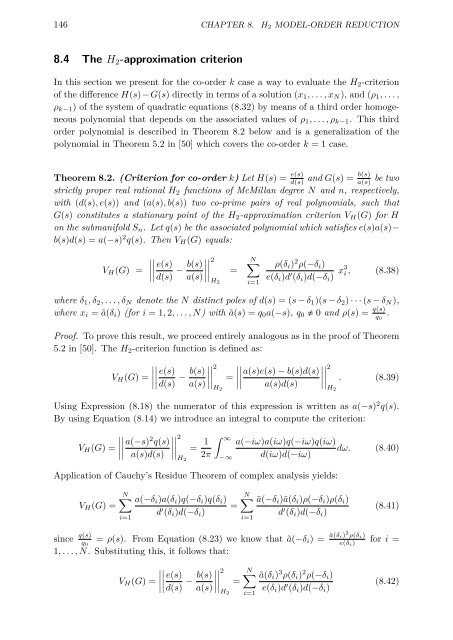link to my thesis
link to my thesis
link to my thesis
Create successful ePaper yourself
Turn your PDF publications into a flip-book with our unique Google optimized e-Paper software.
146 CHAPTER 8. H 2 MODEL-ORDER REDUCTION<br />
8.4 The H 2 -approximation criterion<br />
In this section we present for the co-order k case a way <strong>to</strong> evaluate the H 2 -criterion<br />
of the difference H(s)−G(s) directly in terms of a solution (x 1 ,...,x N ), and (ρ 1 ,...,<br />
ρ k−1 ) of the system of quadratic equations (8.32) by means of a third order homogeneous<br />
polynomial that depends on the associated values of ρ 1 ,...,ρ k−1 . This third<br />
order polynomial is described in Theorem 8.2 below and is a generalization of the<br />
polynomial in Theorem 5.2 in [50] which covers the co-order k = 1 case.<br />
Theorem 8.2. (Criterion for co-order k) Let H(s) = e(s)<br />
d(s)<br />
b(s)<br />
and G(s) =<br />
a(s)<br />
be two<br />
strictly proper real rational H 2 functions of McMillan degree N and n, respectively,<br />
with (d(s),e(s)) and (a(s),b(s)) two co-prime pairs of real polynomials, such that<br />
G(s) constitutes a stationary point of the H 2 -approximation criterion V H (G) for H<br />
on the submanifold S n .Letq(s) be the associated polynomial which satisfies e(s)a(s)−<br />
b(s)d(s) =a(−s) 2 q(s). Then V H (G) equals:<br />
V H (G) =<br />
e(s)<br />
∣∣d(s) − b(s)<br />
a(s) ∣∣<br />
2<br />
H 2<br />
=<br />
N∑<br />
i=1<br />
ρ(δ i ) 2 ρ(−δ i )<br />
e(δ i )d ′ (δ i )d(−δ i ) x3 i , (8.38)<br />
where δ 1 ,δ 2 ,...,δ N denote the N distinct poles of d(s) =(s − δ 1 )(s − δ 2 ) ···(s − δ N ),<br />
where x i =ã(δ i ) (for i =1, 2,...,N) with ã(s) =q 0 a(−s), q 0 0 and ρ(s) = q(s)<br />
q 0<br />
.<br />
Proof. To prove this result, we proceed entirely analogous as in the proof of Theorem<br />
5.2 in [50]. The H 2 -criterion function is defined as:<br />
V H (G) =<br />
e(s)<br />
∣∣d(s) − b(s)<br />
a(s) ∣∣<br />
2<br />
H 2<br />
=<br />
2<br />
a(s)e(s) − b(s)d(s)<br />
∣∣<br />
a(s)d(s) ∣∣<br />
. (8.39)<br />
H 2<br />
Using Expression (8.18) the numera<strong>to</strong>r of this expression is written as a(−s) 2 q(s).<br />
By using Equation (8.14) we introduce an integral <strong>to</strong> compute the criterion:<br />
V H (G) =<br />
a(−s) 2 2<br />
q(s)<br />
∣∣<br />
a(s)d(s) ∣∣<br />
= 1 ∫ ∞<br />
a(−iω)a(iω)q(−iω)q(iω)<br />
dω. (8.40)<br />
H 2<br />
2π −∞ d(iω)d(−iω)<br />
Application of Cauchy’s Residue Theorem of complex analysis yields:<br />
V H (G) =<br />
N∑<br />
i=1<br />
a(−δ i )a(δ i )q(−δ i )q(δ i )<br />
d ′ (δ i )d(−δ i )<br />
=<br />
N∑<br />
i=1<br />
ã(−δ i )ã(δ i )ρ(−δ i )ρ(δ i )<br />
d ′ (δ i )d(−δ i )<br />
(8.41)<br />
since q(s)<br />
q 0<br />
= ρ(s). From Equation (8.23) we know that ã(−δ i )= ã(δi)2 ρ(δ i)<br />
e(δ i)<br />
for i =<br />
1,...,N. Substituting this, it follows that:<br />
V H (G) =<br />
e(s)<br />
∣∣d(s) − b(s)<br />
a(s) ∣∣<br />
2<br />
H 2<br />
=<br />
N∑<br />
i=1<br />
ã(δ i ) 3 ρ(δ i ) 2 ρ(−δ i )<br />
e(δ i )d ′ (δ i )d(−δ i )<br />
(8.42)

















